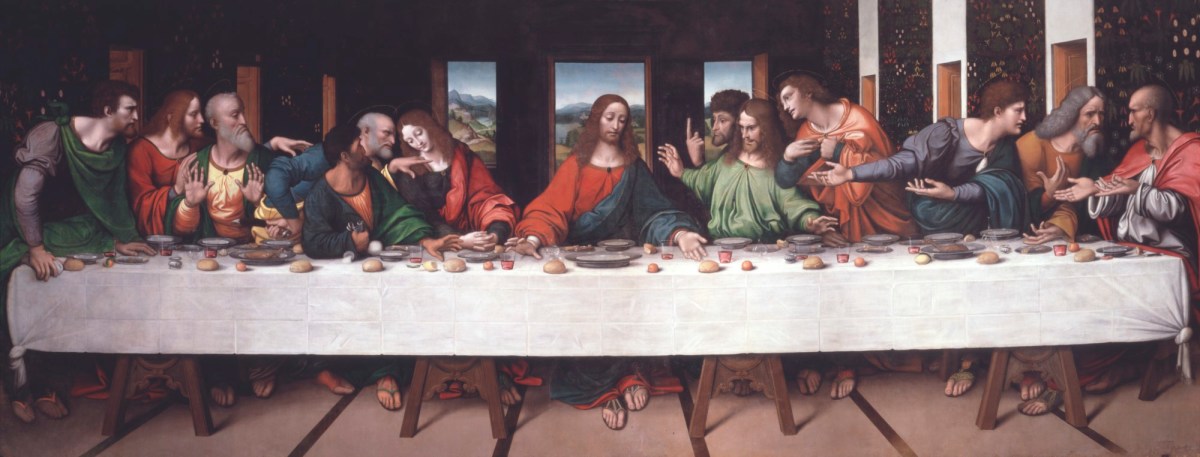
Giampietrino and Giovanni Antonio Boltraffio, Copy of Leonardo's The Last Supper, c.1515-20.
Oil on canvas. 3020 mm x 7850 mm. © Photo: Royal Academy of Arts, London. Photographer: Prudence Cuming Associates Limited.
This image is not available to download. To licence this image for commercial purposes, contact our Picture Library at picturelibrary@royalacademy.org.uk
Copy of Leonardo's The Last Supper, c.1515-20
Attributed to Giampietrino (fl. 1508-1549) and Attributed to Giovanni Antonio Boltraffio (1467 - 1516)
RA Collection: Art
On free display in Collection Gallery
Leonardo's Last Supper (ca. 1495-98) in the refectory of Santa Maria delle Grazie in Milan, was commissioned by his patrons Duke Ludovico Sforza and Beatrice d'Este. The painting represents a scene from the Gospel of John, chapter 13, verse 21, when Jesus announces that one of his Twelve Apostles will betray him. Unlike some earlier depictions of the Last Supper, Leonardo does not give all the apostles halos with the exception of Judas but instead casts Judas' face into shadow to distinguish him from his fellow Apostles.
The Last Supper was executed not in traditional fresco, but in tempera and oil paint on a dry wall. The original has deteriorated very badly as a result of this experimental technique and the dampness of the wall on which it is painted. This early copy, possibly painted around 1520, or even as early as 1515 is almost the same size as the original but lacks the top third of Leonardo's composition. It does however shows details that are not now visible in the original, such as the salt-cellar overturned by the right arm of Judas and the feet of Jesus which were lost when another door was inserted in the refectory wall.
Historically the work was attributed to Marco d'Oggiono (c.1467-1524) and this was the artist named linked to the copy when the Royal Academy bought the painting. More recently it has been attributed to Giampietrino, a pupil of Leonardo although there is also the suggestion that Giovanni Antonio Boltraffio (1467-1516) may have worked on this copy as well.
This copy seems to have been privately owned until it was sold to a Carthusian monastery in Pavia in 1591. The copy remained in the monastery until about 1793 when, following the Austrian suppression of the Carthusian monasteries, it was sold. It was then on display in the Brera Academy in Milan for many years before being sent to England in 1817 to be sold.
Many Royal Academicians went to see the copy and were unanimous in their admiration but it took several years before the RA actually bought the painting. According to Henry Fuseli it was 'rescued from a random pilgrimage by the courage and vigilance of our President who was by then Sir Thomas Lawrence.'
The Royal Academy bought this copy for six hundred guineas from an H. Fraville in 1821. This was the most expensive work of art they had ever bought for the Collection. It required all the Academicians being called to a General Assembly meeting to agree the purchase.
The Royal Academicians were delighted with this painting as they were 'of the opinion that the possession of such a work would be of essential benefit to the Schools of the Academy', according to the Council Minutes of 11 June 1821. It was intended as an example for the students to emulate, and in 1825 Henry Fuseli, in his capacity as Professor of Painting, was able to deliver his eleventh lecture in front of this magnificent record of the original glory of Leonardo's now-faded masterpiece.
Further Reading
Luke Syson and contributors, Leonardo da Vinci: Painter at the Court of Milan, exhibition catalogue, 2011, cat. no. 84, pp. 278-279
Pietro C. Marani, <i>La Copia del Cenacolo della Royal Academy di Londra: Vicende fortuna, attribuzione</i>, LoGisma editore, Milan, 2016
Supported by Christian Levett and Mougins Museum of Classical Art
Object details
3020 mm x 7850 mm
Start exploring the RA Collection
- Explore art works, paint-smeared palettes, scribbled letters and more...
- Artists and architects have run the RA for 250 years.
Our Collection is a record of them.



